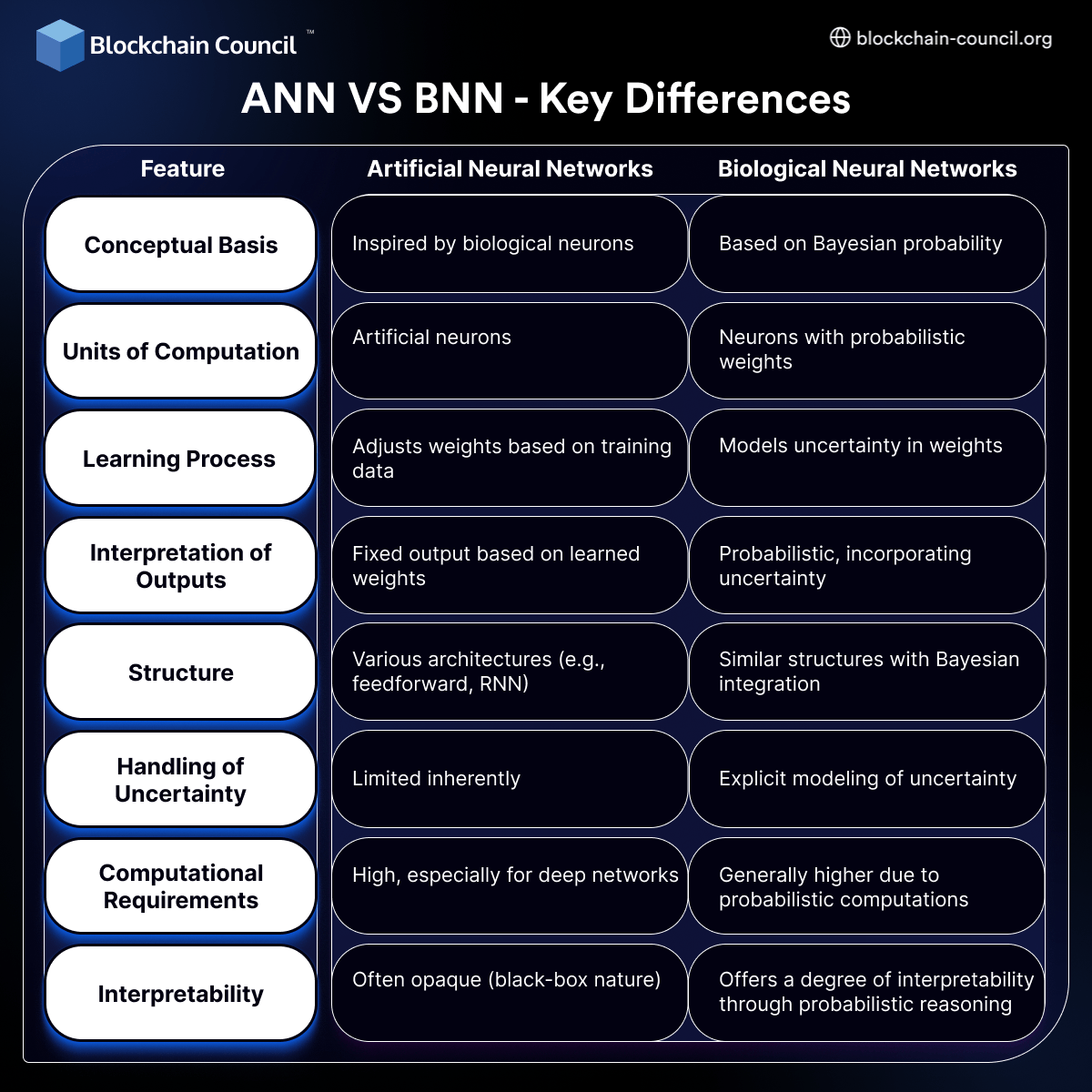
- Blockchain Council
- September 13, 2024
Summary
- ANNs and BNNs are pivotal technologies in the field of artificial intelligence and machine learning, with unique strengths and applications.
- ANNs, inspired by the human brain, consist of interconnected artificial neurons organized in layers and are versatile but resource-intensive.
- BNNs incorporate Bayesian probability principles, providing a measure of uncertainty in predictions and robust handling of real-world data complexities.
- ANNs excel in complex pattern recognition and predictive modeling, while BNNs are valuable for managing uncertainty in decision-making.
- ANNs learn through gradient descent and backpropagation, optimizing weights and biases to minimize prediction error.
- BNNs use Bayesian inference, treating weights as distributions to quantify uncertainty in predictions.
- ANNs are adaptable, fault-tolerant, and suitable for marketing, search engines, healthcare, and retail.
- BNNs excel in measuring uncertainty, offer flexibility, and are ideal for financial modeling, medical decision-making, and automated systems.
- ANNs perform well with large datasets, while BNNs are effective in situations with scarce or uncertain data, offering a probabilistic interpretation of outputs.
- Both ANNs and BNNs have challenges and future trends, with ANNs integrating with other AI technologies and BNNs advancing in Bayesian deep learning and scalable inference techniques.
Introduction
In the rapidly evolving landscape of artificial intelligence and machine learning, Artificial Neural Networks (ANNs) and Bayesian Neural Networks (BNNs) have emerged as two pivotal technologies driving advancements in various fields. Both have their unique strengths, challenges, and applications, making them indispensable tools for researchers and practitioners alike. This article aims to dissect the key differences, applications, and emerging trends in ANNs and BNNs, providing a comprehensive understanding of their roles in the future of AI.
Background and Fundamentals
Artificial Neural Networks (ANNs): Basic Concepts and Architecture
Artificial Neural Networks (ANNs) are a cornerstone in the field of machine learning, inspired by the neuronal structure of the human brain. They consist of interconnected units or nodes known as artificial neurons. These neurons are organized in layers: an input layer, one or more hidden layers, and an output layer. Each neuron in these layers processes the input signal (a real number) and transmits it to the next layer through connections called edges, which are analogous to synapses in a biological brain.
The strength of these connections, represented by weights, is adjustable and plays a crucial role in the learning process of an ANN. The network’s ability to process complex data and learn from it comes from these interconnected neurons and their weighted connections. The output of an ANN can vary, ranging from discrete values to real-valued vectors, depending on the specific task it’s designed for.
Moreover, ANNs are distinguished by their architecture, which can include various types such as feedforward neural networks, where signals flow in one direction, or recurrent neural networks, where connections form cycles. The deep neural network, characterized by multiple hidden layers, is a notable example, enabling the handling of highly complex data structures.
Despite their versatility, ANNs do have limitations. They require substantial computational resources, particularly in terms of parallel processing capabilities. The network’s operation can often be opaque, making it difficult to interpret why or how certain decisions are made. Additionally, there’s no fixed rule for determining the most effective network structure for a given problem, often requiring a trial-and-error approach.
Biological Neural Networks (BNNs): Basic Concepts and Principles
Bayesian Neural Networks (BNNs), while sharing some similarities with ANNs, introduce a different approach to learning and decision-making. BNNs incorporate Bayesian probability principles, offering a probabilistic interpretation of neural networks. This approach provides a measure of uncertainty in the network’s predictions, which can be crucial in decision-making processes where certainty is a factor.
The fundamental difference between BNNs and traditional neural networks lies in how they handle weights and the learning process. In BNNs, the weights are treated as random variables, and their uncertainty is explicitly modeled. This leads to a more robust model that can better handle the complexities and uncertainties inherent in real-world data.
Also Read: How Does AI Work?
Working Mechanism
How Artificial Neural Networks (ANNs) Learn
Artificial Neural Networks (ANNs) learn through a process that involves optimizing their weights and biases to minimize error in predictions. This process primarily employs two fundamental concepts: gradient descent and backpropagation.
- Gradient Descent: This is a standard optimization algorithm used in machine learning to minimize the cost function. The cost function quantifies the error of the model – a lower cost indicates a better-performing model. The gradient descent algorithm aids in finding the parameter values (weights and biases) that minimize this cost function. It works by iteratively adjusting these parameters in the direction that reduces the cost function the most at each step, moving towards a local minimum where the model performs optimally.
- Backpropagation: In tandem with gradient descent, backpropagation is a mechanism that adjusts the weights and biases in a neural network. It involves calculating the gradient of the cost function with respect to each weight and bias in the network, using the chain rule of calculus. This process starts from the output layer and propagates backward through the network, adjusting the weights and biases to reduce the error. Each weight’s adjustment is proportional to its contribution to the total error, with the adjustments guided by the calculated gradient.
How Biological Neural Networks (BNNs) Learn
Bayesian Neural Networks (BNNs) have a different learning mechanism, rooted in Bayesian inference. Unlike ANNs, where learning is about finding the best point estimate for each weight, BNNs treat weights as distributions. This approach allows BNNs to quantify uncertainty in their predictions, a critical aspect in various applications like risk assessment.
- Bayesian Inference in BNNs: BNNs use Bayesian inference to update the distribution of weights based on observed data. Initially, the network starts with a prior distribution over the weights, representing beliefs about the weights before observing any data. As it receives data, the BNN updates these beliefs, leading to the posterior distribution of weights. This process involves calculating the likelihood of the observed data under different weight configurations and combining this with the prior to obtain the posterior distribution.
- Difference from Traditional Learning Methods: The key difference between BNNs and traditional neural networks like ANNs lies in the handling of weights. In ANNs, weights are point estimates refined through training. In BNNs, weights are distributions, and training involves updating these distributions. This fundamental difference allows BNNs to integrate uncertainty directly into their predictions, providing a probabilistic interpretation of their outputs.
Overall, while ANNs focus on optimizing weights to minimize error through methods like gradient descent and backpropagation, BNNs employ Bayesian inference to maintain distributions over weights, incorporating uncertainty directly into the learning process.
Differences between ANN and BNN
While both ANNs and BNNs are powerful tools in the machine learning arsenal, they are suited to different types of problems based on their inherent characteristics and the requirements of the task at hand. ANNs excel in tasks requiring complex pattern recognition and predictive modeling, whereas BNNs are particularly useful in scenarios where understanding and managing uncertainty is crucial.
Performance
Artificial Neural Networks (ANNs) and Bayesian Neural Networks (BNNs) both excel in performance, but their efficiency can vary depending on the complexity of tasks and data availability.
- ANNs are known for their high performance in tasks involving large datasets and complex pattern recognition, such as image and speech recognition. Their ability to learn from vast amounts of data allows for accurate and robust predictions in various domains.
- BNNs, on the other hand, incorporate probabilistic reasoning which can offer better performance in tasks where data is scarce or uncertain. They are particularly effective in scenarios where quantifying uncertainty is crucial, such as in financial risk assessment or personalized medicine.
Accuracy and Uncertainty Handling
The approach to accuracy and uncertainty handling significantly differs between ANNs and BNNs:
- ANNs strive for high accuracy through extensive training on large datasets. However, they may not inherently provide a measure of uncertainty in their predictions, which can be a limitation in risk-sensitive applications.
- BNNs excel in uncertainty handling. They provide not only predictions but also the uncertainty associated with these predictions. This aspect is particularly valuable in fields like healthcare and finance, where understanding the confidence level of predictions is as important as the predictions themselves.
Computational Resources
The computational demands of ANNs and BNNs vary significantly:
- ANNs generally require substantial computational resources, especially for deep neural networks involving large numbers of parameters and layers. Training deep ANNs can be resource-intensive, requiring powerful hardware, often with specialized GPUs.
- BNNs tend to be even more computationally intensive due to the need to compute posterior distributions over weights. The Bayesian inference process, particularly for large networks, can demand significant computational power and sophisticated algorithms to achieve efficient training.
Suitability for Different Types of Problems
The choice between ANNs and BNNs should be guided by the nature of the problem at hand:
- ANNs are well-suited for applications that involve complex pattern recognition, large-scale data processing, and situations where the availability of extensive training data can be leveraged for accurate prediction, such as in autonomous vehicles, language translation, and facial recognition.
- BNNs are preferable in situations where the model needs to express uncertainty in its predictions. They are ideal for tasks that involve making decisions under uncertainty, such as strategic planning under uncertain market conditions, and personalized treatment plans in healthcare, where the reaction to treatments can vary significantly among individuals.
Also Read: Deep Learning vs Machine Learning vs Artificial Intelligence: A Beginner’s Guide
Key Features and Advantages
ANNs: Advantages and Use Cases
Artificial Neural Networks (ANNs) are highly versatile and powerful computational models that have found widespread applications across various sectors. Their ability to process and analyze large datasets makes them indispensable tools in modern computing.
Advantages of ANNs:
- Adaptive Learning: ANNs can modify their behavior based on new data inputs, making them suitable for dynamic environments.
- Fault Tolerance: Due to their parallel structure, ANNs are capable of performing even if some of the neurons become inactive.
- Gradual Corruption: ANNs don’t suddenly fail; their performance degrades gradually as they lose access to some of their inputs.
Use Cases of Artificial Neural Networks:
- Marketing Strategies: ANNs optimize marketing strategies by processing customer data for targeted campaigns. They help in market segmentation, focusing on customers most likely to engage with specific products or services.
- Search Engine Functionality: Search engines like Google use ANNs to improve search results, allowing for more accurate and relevant outcomes.
- Healthcare Industry: ANNs assist in disease identification and diagnosis, particularly in analyzing complex data like MRI images or cancer cell detection.
- Retail Sector: They are employed for sales forecasting, inventory management, and enhancing customer experiences.
BNNs: Advantages and Use Cases
Bayesian Neural Networks (BNNs) introduce a probabilistic approach to neural network learning, making them unique compared to traditional ANNs.
Advantages of BNNs:
- Uncertainty Measurement: BNNs can quantify the uncertainty in their predictions, which is crucial in risk-sensitive applications.
- Flexibility: They are flexible in learning from data, adapting the distribution of weights as more data becomes available.
- Probabilistic Interpretation: BNNs offer a probabilistic interpretation of their model outputs, making them more interpretable than traditional ANNs.
Use Cases of Artificial Neural Networks
- Financial Modeling: In areas like investment and risk assessment, where uncertainty plays a significant role, BNNs are ideal for modeling financial scenarios.
- Medical Decision Making: BNNs can be used to personalize treatment plans, considering the uncertainty in patient responses to different treatments.
- Automated Decision Systems: In systems where decisions must account for uncertainty and variability, BNNs provide a more robust framework.
Challenges and Limitations
ANNs: Overfitting, Interpretability, and Data Requirements
- Overfitting: One of the primary challenges in using Artificial Neural Networks (ANNs) is overfitting. This occurs when a network becomes too well-tuned to the training data, losing its ability to generalize to new, unseen data. Overfitting leads to excellent performance on training datasets but poor performance on real-world or test data. Regularization techniques, dropout layers, and cross-validation are commonly employed to mitigate this issue.
- Interpretability: ANNs, especially deep learning models, are often regarded as ‘black boxes’ due to their complex structure and the opaqueness of their internal decision-making processes. This lack of interpretability can be a significant hurdle in fields that require a clear understanding of how decisions are made, such as healthcare and finance. Efforts like feature visualization and attention mechanisms are ongoing to make these models more interpretable.
- Data Requirements: ANNs require large amounts of labeled data for training to achieve high performance. This dependency can be a limitation in scenarios where acquiring such large datasets is difficult, expensive, or impractical. Furthermore, the quality and diversity of data also significantly impact the model’s performance, posing challenges in ensuring data integrity and representativeness.
BNNs: Computational Complexity, Scalability, and Practical Implementation
- Computational Complexity: Bayesian Neural Networks (BNNs) are computationally more intensive than traditional ANNs. The process of Bayesian inference in these networks, especially for complex models with a large number of parameters, can be computationally demanding. This often requires more sophisticated hardware and can lead to longer training times.
- Scalability Challenges: Scalability is a significant concern in BNNs. As the size and complexity of the network increase, the computational resources required to perform Bayesian inference grow exponentially. This scalability issue limits the practical application of BNNs in large-scale problems and requires innovative solutions like variational inference to approximate the posterior distributions efficiently.
- Practical Implementation Hurdles: Implementing BNNs in practical applications poses its own set of challenges. The need to define prior distributions and interpret posterior distributions requires a deeper understanding of Bayesian statistics. Additionally, the integration of BNNs into existing machine learning pipelines is not always straightforward, given their unique computational requirements and the need for specialized software and tools.
Also Read: What is Artificial Intelligence (AI) Governance?
Future Directions and Trends
Emerging Trends in ANNs:
- Integration with Other AI Technologies: The convergence of ANNs with other AI technologies like reinforcement learning and natural language processing is a growing trend. This integration is likely to result in more sophisticated AI systems capable of performing complex tasks with greater efficiency.
- Advancements in Deep Learning Architectures: Researchers are continually developing new deep learning architectures that promise to enhance the capabilities of ANNs in processing vast and complex datasets.
- Energy-efficient and Compact Models: With the increasing awareness of the environmental impact of large-scale computing, there’s a push towards creating more energy-efficient and compact ANN models without compromising on performance.
Potential Future Developments in ANNs:
- Self-learning and Adaptive Networks: Future ANNs are expected to be more self-reliant, capable of learning and adapting autonomously in real-time, reducing the need for extensive training datasets.
- Explainable AI (XAI): There is a growing demand for making ANNs more interpretable or explainable, especially in critical areas like healthcare and autonomous driving.
Emerging Trends in BNNs:
- Advancements in Bayesian Deep Learning: Integration of Bayesian methods with deep learning is gaining traction, offering models that can better handle uncertainty and provide more reliable predictions.
- Scalable Inference Techniques: Research is focused on developing scalable inference techniques to make BNNs more practical for large-scale applications.
Potential Future Developments in BNNs:
- Hybrid Models: The development of hybrid models that combine the strengths of ANNs and BNNs is an exciting area of research. These models aim to leverage the uncertainty quantification of BNNs and the robust performance of ANNs.
- Application in Uncertain Environments: BNNs are poised to play a crucial role in applications involving uncertain or incomplete data, such as in exploratory robotics or complex system modeling.
Conclusion
ANNs and BNNs are at the forefront of the AI revolution, each with its distinct approach to learning and problem-solving. While ANNs excel in handling large datasets and complex pattern recognition, BNNs offer the advantage of dealing with uncertainty and providing probabilistic outputs. The future will likely witness these technologies becoming more advanced, efficient, and integrated, addressing their current limitations and opening new avenues for research and application. As they evolve, ANNs and BNNs will continue to be integral in shaping the future of AI, offering more intelligent, adaptable, and reliable solutions across various domains.
Frequently Asked Questions
What is the main difference between Artificial Neural Networks (ANNs) and Bayesian Neural Networks (BNNs)?
- ANNs are inspired by the structure of biological neurons and consist of interconnected artificial neurons organized in layers.
- BNNs, on the other hand, incorporate Bayesian probability principles and treat weights as probability distributions, explicitly modeling uncertainty.
In which types of applications are ANNs most suitable?
- ANNs excel in applications that involve complex pattern recognition, large-scale data processing, and situations where extensive training data is available.
- Some common use cases for ANNs include optimizing marketing strategies, improving search engine functionality, assisting in disease identification and diagnosis, and enhancing customer experiences in the retail sector.
Where are Bayesian Neural Networks (BNNs) particularly advantageous?
- BNNs are advantageous in scenarios where understanding and managing uncertainty is crucial.
- They are well-suited for applications such as financial modeling, medical decision-making (especially personalized treatment plans), and automated systems where decisions must account for uncertainty and variability.
What’s in store for the future of Artificial Neural Networks (ANNs) and Bayesian Neural Networks (BNNs)?
For ANNs:
- ANNs are joining forces with reinforcement learning and natural language processing, leading to smarter and more efficient AI systems.
- Research is focusing on creating eco-friendly, compact models without compromising performance.
- Efforts are ongoing to make ANNs more interpretable, especially in healthcare and autonomous driving.
For BNNs:
- BNNs are diving deeper into Bayesian deep learning and scalable inference techniques.
- Expect the emergence of hybrid models combining the strengths of ANNs and BNNs.
- BNNs are set to excel in uncertain environments, like exploratory robotics and complex system modeling, offering new possibilities.






































































 Guides
Guides News
News Blockchain
Blockchain Cryptocurrency
& Digital Assets
Cryptocurrency
& Digital Assets Web3
Web3 Metaverse & NFTs
Metaverse & NFTs
